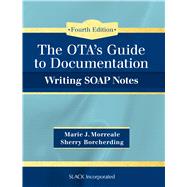Written in an easy-to-read- format, this Fourth Edition by Marie J. Morreale and Sherry Borcherding will aid occupational therapy assistants (OTAs) in learning the purpose and standards of documentation throughout all stages of the occupational therapy process and different areas of clinical practice.
Essentials of documentation, reimbursement, and best practice are reflected in the many examples presented throughout The OTA’s Guide to Documentation: Writing SOAP Notes, Fourth Edition, including a practical method for goal writing (COAST), which is explained thoroughly.
Worksheets and learning activities provide the reader with multiple opportunities to practice observation skills and clinical reasoning, learn documentation methods, create occupation-based goals, and develop a repertoire of professional language. Answers to all the worksheets are provided to enable independent study, and a detachable summary sheet can be pulled out and carried to clinical sites as a reminder of the necessary contents for a SOAP note.
Templates are provided to assist beginning OTA students in formatting occupation-based SOAP notes and the task of documentation is broken down into smaller units to make learning easier. Other formats and methods of recording client care are also explained, such as the use of electronic health records and narrative notes. This text also presents an overview of the initial evaluation process delineating the roles of the OT and OTA and guidelines for implementing appropriate interventions.
New in the Fourth Edition:
- Incorporation of the Occupational Therapy Practice Framework: Domain and Process, Third Edition and other updated American Occupational Therapy Association documents
- Additional information on electronic health records and more examples from emerging niches of occupational therapy practice
- Updated information to meet Medicare Part B and other third party payer requirements
- Additional lists of professional language and abbreviations
- Extra tips for avoiding common documentation mistakes
- New tables, worksheets, and learning activities
Updated with new features and information,The OTA’s Guide to Documentation: Writing SOAP Notes, Fourth Edition offers both the instruction and multiple opportunities to practice documentation, providing OTAs with the necessary skills to record client care effectively.
Bonus Video Content:
When you purchase a new copy of The OTA’s Guide to Documentation: Writing SOAP Notes, Fourth Edition, you will receive access to scenario-based videos to practice the documentation process.









